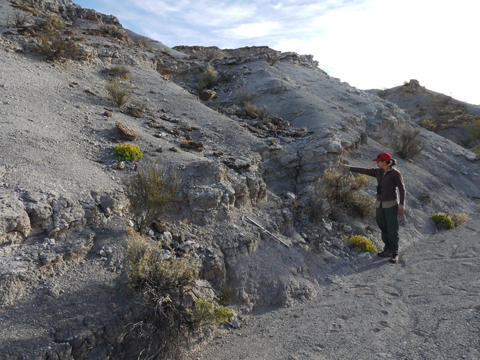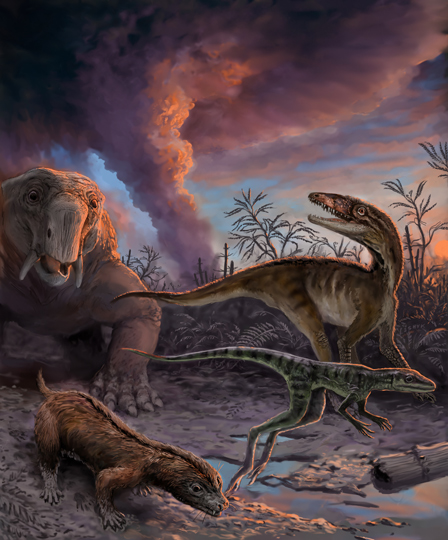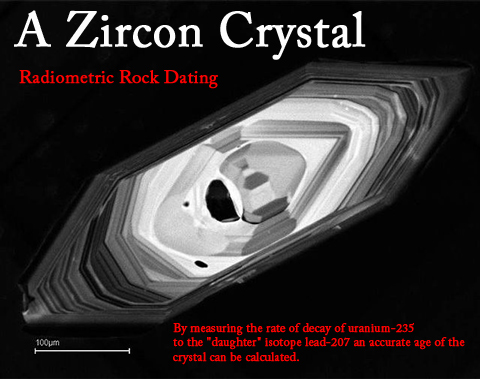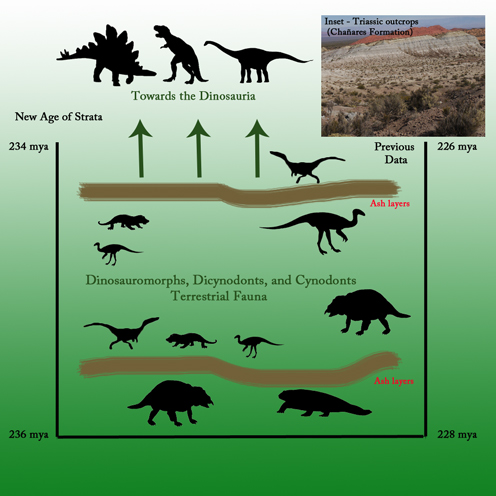New Study Suggests the Dinosaurs Evolved Quickly
An international team of researchers have accurately dated rock layers exposed in north-western Argentina deposited during the Triassic. The subsequent geological timeline they have been able to construct suggests that the time elapsed between the emergence of early dinosaur relatives and the origin of the first dinosaurs is much shorter than previously believed. In essence, the dinosaurs evolved quickly, the Dinosauria evolved much more rapidly than previously thought.
North-western Argentina Around 235 Million Years Ago
Picture credit: Victor Leshyk
The Triassic – A Time of Transition
The vertebrate fauna of the Triassic (approximately 251 million to 201 million years ago), changed dramatically. Few of the fossil lineages found in Lower Triassic rock formations can be found in strata laid down later on. The mass extinction event that marked the end of the Palaeozoic and the beginning of the Mesozoic led to a radical shift in the diversity, type and geographical distribution of back-boned land animals and arguably, the emergence of more modern-looking ecosystems.
To help unravel some of the mysteries surrounding this “faunal shift” and to more accurately date the appearance of the first dinosaurs, the scientists travelled to north-western Argentina (La Rioja Province) and set about dating different beds that make up the exposed sandstones and mudstones of the Chañares Formation.
The Dinosaurs Evolved Quickly
The debate as to where and exactly when the first dinosaurs evolved is one of those topics that comes up frequently at symposiums and conventions. The evidence suggests that the Dinosauria first appeared in the Southern Hemisphere and for a long time South America was thought to have been the place they originated from. Research published in 2013 challenged this idea, proposing that Africa may have been home to the first dinosaurs, but exactly when did the dinosaurs as an Order of reptiles (Dinosauria) really take off? At what point in geological time did the dinosaurs commence their journey to becoming the dominate terrestrial life forms of the Mesozoic?
To read an article regarding the possibility of dinosaurs having first evolved in Africa: Africa – The Cradle of the Dinosauria?
Problems Accurately Dating Deep Time
The sedimentary exposures of the Chañares Formation permit accurate stratigraphic dating because of a quirk of fate. Back in the Triassic, this part of the world was a lush, tropical paradise, however, nearby volcanoes from time to time deposited vast amounts of ash in the area. These ashes formed easily recognisable layers (called tuffs) and within these layers the scientists, which included researchers from the University of Buenos Aires, the University of Brasília (Brazil), along with American colleagues and collaborators from Argentina’s National Scientific and Technical Research Council, were able to identify microscopic crystals called zircons. It is these zircon crystals that hold the key to accurate dating of geological deposits.
Zircon Crystals and Radiometric Dating of the Chañares Formation
Picture credit: Everything Dinosaur
The research team took samples from the various ash layers and noted their position within the sedimentary beds and the vertebrate fossils associated therein. Zircon crystals were identified within the volcanic layers and these were radiometrically dated using the ratio of uranium decay to lead isotopes. In this way, thanks to advances in mass spectrometry the team were able to determine an accurate age of the zircon and by inference the age of the fossil bearing sedimentary layers above and below the ash layers.
Dating Zircon Crystals Using Uranium Decay
The technique has been used before, for example to date the lower portions of the Chinle Formation of the United States (U-PB ID-TIMS zircon geochronology dating method [uranium to lead]).
So what would have been bad luck for the fauna and flora around at the time, a devastating deposit of choking volcanic ash, has permitted palaeontologists to be able to date with considerable accuracy the deposition timeline of this part of the Chañares Formation.
Identifying the Ash Layers for Sampling (Chañares Formation)

Co-author Adriana Mancuso (National Scientific and Technical Research Council) points to a volcanic ash layer (tuff) in the Chañares Formation that was sampled for radiometric dating.
Picture credit: Randall Irmis (University of Utah)
What Does the Accurate Triassic Timeline Reveal?
It had been thought that the strata was around 226 to 228 million years old (early Late Triassic, the Carnian faunal stage). However, this study indicates that these rocks were laid down much earlier in the Triassic, perhaps 5 to 10 million years earlier, making the rocks, effectively Middle Triassic in age (234 to 236 million years old, the Ladinian faunal stage). Fossils of dinosaur precursors, known as dinosauromorphs, Archosaurs that are very closely related to the Dinosauria and the ancestors of the dinosaurs are found in these rocks.
The first dinosaur fossils date from around 230 million years ago approximately, perhaps even earlier. This means that the true dinosaurs evolved from the dinosauromorphs much quicker than previously thought. There was a much more rapid transition from a world with dinosauromorphs to a terrestrial ecosystem with dinosaurs in it. In short, dinosaurs very quickly became established – dinosaurs evolved quickly.
The Fossil Assemblage of the Chañares Formation (Schematic Diagram)
Picture credit: Everything Dinosaur (inset photograph Randall Irmis)
Everything Dinosaur stocks a wide variety of Triassic figures and replicas: Triassic Models and Figures.
Commenting on the significance of this new study, which has just been published in the Proceedings of the National Academy of Sciences (USA), Randall Irmis stated:
“To discover that these early dinosaur relatives were geologically much younger than previously thought was totally unexpected.”
What Does This Mean for Other Middle Triassic Formations Elsewhere?
This shift in the date for these deposits that make up a portion of the Chañares Formation has serious implications for other fossil-bearing strata that were also believed to represent the Middle Triassic. Similar types of vertebrate fossil are found in the Santa Maria Formation (southern Brazil) and in the Karoo Basin (South Africa), but none of these formations have been radiometrically dated. These too, could be 5 to 10 million years older than previously thought.
Summarising the research a spokesperson from Everything Dinosaur explained:
“The geological dates for certain fossil assemblages may have to be reconsidered in the light of these findings. The evolution and subsequent radiation of the Dinosauria has become somewhat concertinaed. This research suggests a much more rapid evolution from dinosauromorphs to true dinosaurs than previously thought.”
Why Did the Dinosaurs Evolve Rapidly?
The first dinosaurs believed to have evolved were the saurischian theropods.
These archosaurs were bipeds and their skeletons show that they had an advantage over many of the other predators (bipedal and quadrupedal) around at the time. Firstly, the pelvic area has a fully open acetabulum (the rounded hole in the pelvis where the head of the femur fits). This allows the hind legs to locate much more directly under the body, providing a more efficient locomotion. Secondly, the femur itself has a ball-shaped head turned slightly inward to slot into the acetabulum. This arrangement, also supports the hind legs located directly under the hips.
These anatomical features, (plus one or two others), evolved to permit these theropods to develop stronger legs making them faster and more powerful than other archosaurs. These strong legs seem to have enabled the dinosaurs to “sprint out of the evolutionary blocks”, leading to their domination of terrestrial ecosystems for the best part of 160 million years or so.









Leave A Comment